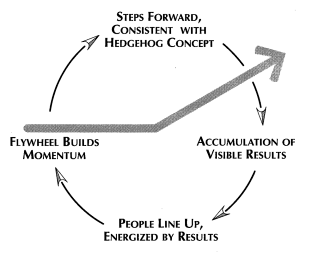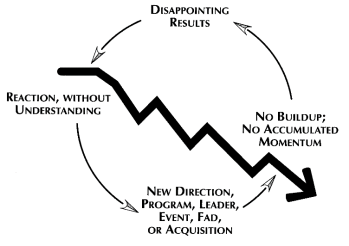
This week, we continue our journey on building high performance teams, but first, some (mostly tech) news:
I was sent an article about Magic Leap by my brother a few weeks ago and the article’s title claims that the company is changing computing forever. I first talked about Magic Leap a few months ago when I was covering the various virtual/augmented reality companies out there, but this article by Forbes goes quite a ways further in exploring this company than anything that was available at that time. Magic Leap is getting a glut of venture capital money, and with good reason it seems, as their product, a next-generation interface for working with computers, could be what we use for decades to come. Their new interface, in essence glasses, completely changes how we interface with our world by mixing virtual and augmented reality in a way that creates a mixed reality experience that overlays your real world experience by projecting imagery directly on your retina through an optics system built into semitransparent glass. If you skip everything else this week, don’t skip this – this technology, if it comes to market, will change everything about how we interact with our world.
Speaking of change, Fortune this week had a great one on Satya Nadella over at Microsoft. I know, I often write about my former employer, but I got to work with Satya while I was there, and while at first I had my own doubts about an insider being chosen to chart the new course for the company, he continues to impact the company, it’s culture, and it’s people in ways that are transforming them into the multi-national change agent they have the potential to be.
There are a few articles from Harvard Business Review worth checking out around Artificial Intelligence and teaching algorithms right from wrong. Additionally, they discuss the competitive landscape of machine intelligence and how to make your company ready for machine learning. Along with that is this video with Hilary Mason on the impact of AI technologies from O’Reilly media. Last, this article from TechCrunch digs into how we define our relationship with early AI.
Strategy+business rightly digs into the shift in industry from products to programming, tracking how research and development dollars and the impact that early investment in software has on revenue growth. It’s going to make for an interesting future state when artificial general intelligence creates greater access for all companies (and individuals) to create software in novel ways.
Another article from s+b this week I think is worth sharing: we’re told that smartphones are “bad for our health” and that of our employees, but the reality is our bad management is the root cause. Just because we have the ability to be connected (to our people) 24/7, doesn’t mean we should be. Here’s an interesting idea: that constant access to our people has an adverse impact on their productivity and engagement. But don’t take my word for it. “Smartphones are not the problem. But the endless connectivity they provide means that work time is no longer finite. In many organizations, the result is that managerial incentives to use employees’ time effectively are at a new low.”
Now that next step on the high-performance team journey, in the form of a book report of sorts:
Good is the Enemy of Great
In his book Good to Great, Jim Collins hits it on the head by starting with the premise that by settling for good, many companies never position themselves for greatness and even if they have “great” leaders, when that leadership goes away since they were only good companies to begin with, the ability to sustain “good-ness” is difficult and many companies slide into mediocrity. The intent of the book, however, is to identify what took certain businesses from good to great.
He places an emphasis on how a good company can be transformed to a great company through research of certain companies he considers great and comparison companied from similar sectors. The performance of the companies was based on the performance of their stock versus both the stock market as a whole and the specific comparison companies. Through their research, Collins’ team discovered the following insights:
- Larger than life: Companies that were run by larger-than-life CEOs were much more likely to fail either while that CEO was in power or immediately after. Most of the celebrity-led companies show the positive correlation with taking good to good or mediocre. Good to great takes a leader who is humble.
- There is no linking between executive compensation and the process of going good to great
- Both good to great and comparison companies had strategic planning
- Mergers and acquisition has no impact on the movement of a good to great company
- The good to great company didn’t necessarily have people trained in managing change, motivation or creating alignment
- There was also a lack of awareness of any official “launch event” for the transformation – it was organic
- It is not necessary for good to great companies to be at large or in an industry that is at an advantage due to innovation/newness – in fact, all of the Good to Great companies were established in the 1960s or earlier (mid-1800s for one)
- Most of the good to great companies focus on what they should stop instead of what they should do
- Technology was not cause for transformation in the good to great companies – many times, technological advances would happen after or along the way but were never the impetus
So what was the impetus for change?
Level 5 Leadership
Collins identifies that what he calls “Level 5 Leadership” was the driver for the transformation from good to great. SO what is Level 5 Leadership?
Level 5 leaders do what they do for the success of the company, not individual recognition. These leaders demonstrate humility and a professional will that reveals a fierce resolve to do what was best for the company, no matter how radical it might be – as Collins puts it, an unwavering resolve to do what must be done.
- Level 5 leaders set their people up for success by putting a culture in place that supports succession
- Level 5 leaders are quiet and dogged by nature, relentless in their pursuit of the core purpose they’ve identified for the company
- Most companies have (and are successful with) Level 4 leaders, but they won’t realize the market outperformance of their competitors who have a Level 5 leader
- They were more than just “clock builders”, they had unique characteristics such as humility and professional will towards excellence. This type of a leader is known for taking credit for bad performance while giving credit to others when things go well
- Conceptually it’s a shift to think about the simple desire to produce sustainable results through a dedication to doing whatever it takes, big or small, to achieve greatness versus the quick fix mentality prevalent today
| Professional Will |
Personal Humility |
| Creates superb results, a clear catalyst in the transition from good to great. |
Demonstrates a compelling modesty, shunning public adulation; never boastful. |
| Demonstrates an unwavering resolve to do whatever must be done to produce the best long-term results, no matter how difficult. |
Acts with quiet, calm determination; relies principally on inspired standards, not inspiring charisma, to motivate. |
| Sets the standard of building an enduring great company; will settle for nothing less. |
Channels ambition into the company, not the self; sets up successors for even greater success in the next generation. |
| Looks into the mirror, not out the window, to apportion responsibility for poor results, never blaming other people, external factors, or bad luck. |
Looks out the window, not in the mirror, to apportion credit for the success of the company – to other people, external factors, and good luck. |
First Who, Then What
Collins talks about that, while people are important, it’s making sure you have the right people in the right roles that creates value. In essence, people are not our most important asset – the right people in the right roles are. As he says, you have to make sure not only that you have the right people on the bus, but that they are in the right seats. Foundational to this is making sure we hire people whose personal values match our business values. Whether someone is the right person has more to do with their character and abilities than what they know or have done.
- Hire people with characteristics you cannot easily instill and focus on who you are paying
- Analyze a potential employee’s character, work ethic, intelligence, and dedication to their values before deeply analyzing credentials and practical skills
- A core difference between Level 5 and Level 4 leaders is that a 4 will look first at what they want to accomplish and then determine who they want to hire. A 5 leader focuses on the who, including building a superior executive team, before considering what the path to greatness is
Great companies are a rigorous culture and if you don’t have what it takes to succeed, you won’t last long, but not in a ruthless manner. This, to me, it a key differentiation that people should consider when they are looking for companies to work for. Most people simply look for a job, not something about which they can be passionate – this is a key difference about success.
- When in doubt, don’t hire – keep looking
- When you know you need to make a people change, act immediately
- Don’t churn for the sake of churn, churn because you need to and churn better
- At the same time, you may have someone who is a great fit to the culture but not their particular job – the responsibility of a leader is to get them in the right job/seat
- Put your best people on your biggest opportunities, not your biggest problems
As Collins says, “good-to-great management teams consist of people who debate vigorously in search of the best answers, yet who unify behind decisions, regardless of parochial interests.” It needs to be a team that can confront brutal facts that face a company, but will never lose faith in the company. Many time, we expect a quick fix to solve a problem, but breakthroughs occur because of a series of good decisions that are diligently executed on and accumulate one on top of the other. As a leader, charisma can be a disadvantage because your subordinates will hide facts from you because they want you to like them or don’t want to disappoint you with bad news. This isn’t the first time we’ve heard this, as Lencioni makes this point as well.
The key isn’t to motivate people, but to not de-motivate them – when you have the right people on the bus, they will be self-motivated. To do so, we need to create a climate where the truth is spoken AND heard and brutal facts are confronted. To that end, we lead with questions, not answers and have the humility to grasp that you don’t know everything nor do you understand enough to have all the answers so you have to ask questions that gets you to the right insights.
- Engage in dialogue and debate, not coercion
- You have to have a desire to have intense dialogue and rigorous debate – engage in a search to find the best answers by questioning a premise, not the value of people
- Always keep it about the situation at hand, never about individuals
- Conduct autopsies, without blame
- As the leader, you are always in the end to blame for failures and you have to take responsibility for it but you also have to extract the maximum learning you can from the situation
- With the right people on the bus, you’ll never need to assign blame but only search for true understanding and learning
- Build red flag mechanisms that turn information into information that cannot be ignored
- Good to great companies have no better access to information than any other company. They simply give their people and customers’ ample opportunities to provide unfiltered information and insight that can act as early warning for potentially deeper problems
Collins wraps all this into what he calls the Stockdale Paradox:
| Retain faith that you will prevail in the end, regardless of the difficulties. |
AND at the same time |
Confront the most brutal facts of your current reality, whatever they might be. |
The Stockdale paradox is named after Admiral James Stockdale who was held as a prisoner of war for eight years during the Vietnam War. Stockdale was tortured and beaten during this ordeal and never had any reason to believe he would ever be able to leave, let alone see his wife again. But through it all, he never lost faith. “I never doubted not only that I would get out, but also I would prevail in the end and turn the experience into the defining event of my life, which, in retrospect, I would not trade.”
Here is the paradox: While Stockdale had unbelievable faith that things would work out, he said that it was always the most optimistic of his fellow POW’s who actually were the ones who failed to make it out alive. “They were the ones who said, ‘We’re going to be out by Christmas.’ And Christmas would come, and Christmas would go. Then they’d say, ‘We’re going to be out by Easter.’ And Easter would come, and Easter would go. And then Thanksgiving, and then it would be Christmas again. And they died of a broken heart.” By setting unrealistic, fantasy-based expectations, it was easier for them to give up, and in the end, many of them did.
The Hedgehog Concept (Simplicity within the Three Circles)
Next we explore the Hedgehog Concept, or, the “one big thing” for our organizations to understand and stick to. The question we need it as is what does or can your organization do, understand, or use as your core solution to competitive threats and changes in the industry?
- The concept itself is similar to your core ideology (which never changes), differing only in the sense that it can be slightly less permanent.
- Crucial distinction is that this isn’t a goal, strategy or intention – it is an understanding of what you can be the best at which is a crucial distinction
- Your hedgehog concept must be something you are deeply passionate about, best at in the world, and are able to make a profit by doing.
- Figure out what falls into all three of these categories, and obtain an understanding and strategy based on it.
Passion: Good to great companies did not pick a course of action and then encourage their people to become passionate about their direction. Rather, those companies decide to do only those things that they could get passionate about. They recognized that passion cannot be manufactured nor can it be the end result of a motivation effort.
What you are best at:
- Goes far beyond core competence.
- Just because you possess a core competence doesn’t necessarily mean you are the best in the world at that competence.
- Conversely, what you can be best in the world at might not even be something in which you are currently engaged.
- The Hedgehog concept is not a goal or strategy to be the best at something, it is an understanding of what you can be the best at and almost equally important on what you cannot be the best at
What makes a profit:
- Search for the one dominator that has the single greatest impact
- Sometimes quite subtle, even unobvious but the key is to use the question of the denominator to gain understanding and insight into your economic model
- Even if you can’t find a single denominator, the challenge of the question will drive you to much deeper insight which is the purpose of having the denominator in the first place – that it ultimately leads to more robust and sustainable economics
You have to be willing to “transcend the curse of competence” and avoid doing many things simply because you can but instead focus on that one piece that you can do best. It’s an iterative process that is not the result of an individual but a council:
- Exists to gain understanding about important issues facing the organization
- Assembled and used by leading executive and consists of 5 – 7 people
- Each member has ability to argue and debate in search of understanding but not from ego or to protect an interest
- Respect is maintained without exception
- Come from a range of perspectives but each member has deep knowledge about some aspect of organization
- Includes key management team members but is not limited to that group nor is everyone from management team a part
- Standing body, not an ad hoc committee assembled for a specific project – it has longevity
- Rhythm of meeting determined by situation at hand
- Does not seek consensus, recognizing that consensus decisions are typically at odds with intelligent decisions – in the end, the final decision rests with the leader
- Informal body, not listed on any formal organizational chart or document
- Usually have innocuous or benign names
The hedgehog concept is not a goal, strategy or intention; it is an understanding that good to great companies use to find their “one big thing” and stick to it.
A Culture of Discipline
Collins then explores how we create a culture of discipline. He makes the point that we need to hire people who are disciplined in their own right. The second you need to manage someone, you have made a hiring mistake and we should focus on managing systems, not people. Collins believes this is superior to managing people because:
- When you have disciplined people, you do not need hierarchy.
- When you have disciplined thought, you do not need bureaucracy.
- When you have disciplined action, you do not need excessive controls.
To that end, we need to build a culture full of self-disciplined people who take disciplined action, fanatically consistent with the three circles and the hedgehog concept. We need to give our people freedom and responsibility within a framework — build a consistent system with clear constraints, but give people freedom and responsibility within the framework of that system. When bureaucratic culture arises, it is to compensate for incompetence and lack of discipline, which arise from having the wrong people on the bus in the first place. Therefore, we build a culture around the idea of freedom and responsibility, within a framework and then fill that culture with self-disciplined people who are willing to go to extreme lengths to fulfill their responsibilities. They will “rinse their cottage cheese.” That said, we must be careful not to confuse a culture of discipline with a leader who is a tyrannical disciplinarian.
All in all, G2G companies have the courage to say no to big opportunities that stray outside their three circles, even if it is a once-in-a-lifetime opportunity – in fact, the more G2G companies stayed within their three circles, the more they had opportunities for exponential growth
Technology Accelerators
So what about technology? Collins notes that with Good to Great companies, technology is an accelerator of momentum, not a creator of it. Great companies use it to execute better, but it won’t save a mediocre company. They also avoid technology fads and bandwagons but they become pioneers in the application of carefully selected technology. None of the G2G companies began their transformations with pioneering technology, however they became pioneers in the application of technology once they grasped how it fit with their three circles and after they hit breakthrough.
Great companies respond with thoughtfulness and creativity, driven by a compulsion to turn unrealized potential into results, mediocre companies react and lurch about motivated by fear of being left behind
Technology is never the source of either greatness or decline for a company, it all comes down to culture.
The Flywheel and the Doom Loop
This refers to the idea of momentum – keep pushing in one direction and you’ll build up the momentum needed to help you to overcome obstacles. By using the flywheel as a metaphor, Collins stresses how momentum is built a little bit at a time – it’s not a dramatic, revolutionary change, but constant, diligent work over years. While good to great transformation often looks like dramatic, revolutionary from the outside, internally they feel like organic, cumulative processes. The confusion of end outcomes (dramatic result) with
While good to great transformation often looks like dramatic, revolutionary from the outside, internally they feel like organic, cumulative processes. The confusion of end outcomes (dramatic result) with process (organic and cumulative) skews our perception of what really works over the long haul. No matter how dramatic the end result, the good-to-great transformation never happened in one fell swoop. There was no single defining action, no grand program, no one killer innovation, no solitary lucky break, no miracle moment. Sustainable transformations follow a predictable pattern of buildup and breakthrough. Like pushing on a giant, heavy flywheel, it takes a lot of effort to get the thing moving at all, but with persistent pushing in a consistent direction over a long period of time, the flywheel builds momentum, eventually hitting a point of breakthrough. Unfortunately, we’ve allowed the way transition looks from the outside to drive how we perceive
Like pushing on a giant, heavy flywheel, it takes a lot of effort to get the thing moving at all, but with persistent pushing in a consistent direction over a long period of time, the flywheel builds momentum, eventually hitting a point of breakthrough. Unfortunately, we’ve allowed the way transition looks from the outside to drive how we perceive change in a company when in reality the process is much slower and, in a sense, the result of a million turns of the flywheel as it builds up momentum.
FLYWHEEL MODEL:

When Collins looked at comparison companies, he noted they followed a different pattern, the doom loop.
DOOM LOOP MODEL:
Rather than accumulating momentum-turn by turn of the flywheel-they tried to skip buildup and jump immediately to breakthrough. Then, with disappointing results, they’d lurch back and forth, failing to maintain a consistent direction. Comparison companies frequently tried to create a breakthrough with large, misguided acquisitions whereas G2G companies, in contrast, principally used large acquisitions after breakthrough, to accelerate momentum in an already fast-spinning flywheel.
- In “doom loop” company, every time a new executive comes in, a new fad for management/vision/goals grinds the flywheel to a halt and results in doom loop. In contrast, with each new leader the flywheel keeps turning in G2G companies
- G2G companies had same short-term pressures for returns on them as their competitors, however they had the patience an discipline to follow the buildup-breakthrough flywheel model despite this external pressure – similar to how Wooden took years to build a program that would eventually create a dynasty of winning for more than a decade at UCLA
- G2G companies did have incredible commitment and alignment, but they didn’t think about it – they focused on the fundamentals and let the momentum over time do the rest – it was transparent to them and in that, came the commitment, alignment, motivation and change that just made problems melt away – they first learned how to put on their socks and built it from there

How to tell if you’re on the Flywheel or in the Doom Loop
| Signs that you’re on the Flywheel |
Signs that you’re in the Doom Loop |
| Follow a pattern of buildup leading to breakthrough |
Skip buildup and jump right to breakthrough |
| Reach breakthrough by an accumulation of steps, one after another, turn by turn of the flywheel; feels like an organic evolutionary process |
Implement big programs, radical change efforts, dramatic revolutions; chronic restructuring – always looking for a miracle moment or new savior |
| Confront the brutal facts to see clearly what steps must be taken to build momentum |
Embrace fads and engage in management hoopla, rather than confront the brutal facts |
| Attain consistency with a clear Hedgehog Concept, resolutely staying within the three circles |
Demonstrate chronic inconsistency – lurching back and forth and straying far outside the three circles |
| Follow the pattern of disciplined people (“first who”), disciplined thought, disciplined action |
Jump right to action, without disciplined thought and without first getting the right people on the bus |
| Harness appropriate technologies to your Hedgehog Concept to accelerate momentum |
Run about like Chicken Little in reaction to technology change, fearful of being left behind |
| Make major acquisitions AFTER breakthrough (if at all) to accelerate momentum |
Make major acquisitions before breakthrough, in a doomed attempt to create momentum |
| Spend little energy trying to motivate or align people; the momentum of the flywheel is infectious |
Spend a lot of energy trying to align and motivate people, rallying them around new visions |
| Let the results do most of the talking |
Sell the future to compensate for a lack of results |
| Maintain consistency over time, each generation builds on the work of previous generations; the flywheel continues to build momentum |
Demonstrate inconsistency over time; each new leader brings a radical new path; the flywheel grinds to a halt, and the doom loop begins anew |
In all of this, there is only one area I disagree with: Collins’s belief that the flywheel doing all the communicating you need (I exaggerate) – I think a key component of any leader’s role is to communicate even the simplest of goals again and again and showing the employees where along the track they are. Why? Well, because no matter how simple an idea, when you start to work on anything you can get so augured in you can only see the weeds, not even the trees or the forest. It is critical that the leader bring everyone back up for air with regularity and also be a source of inspiration (not in an ego-based way) to the entire workforce.
Well, if you’ve made it this far, you’re likely expecting a TED video about some topic. We’ll get to that in a moment, but first, contrary to everything else I’ve been writing, there’s a funny piece from a while back by Geekwire about the top ten reasons why Darth Vader was an amazing project manager.
Right, so in parting this week, I leave you with this TED talk by Dan Ariely where he discusses what it is, in his mind, that motivates us to work.











